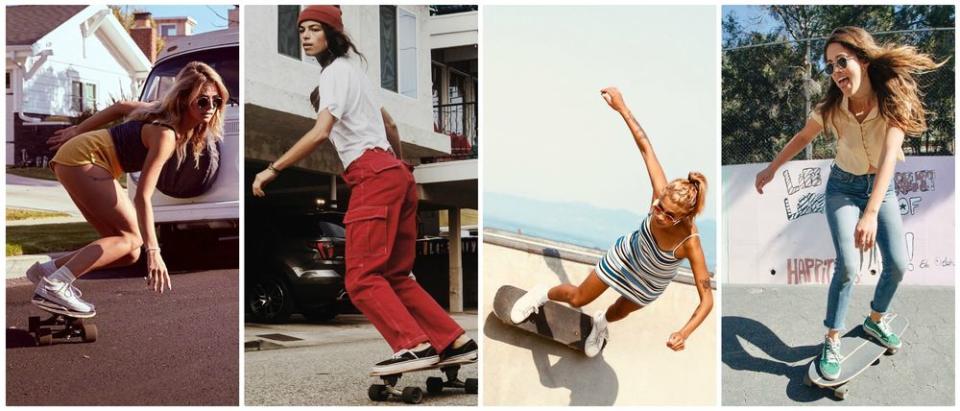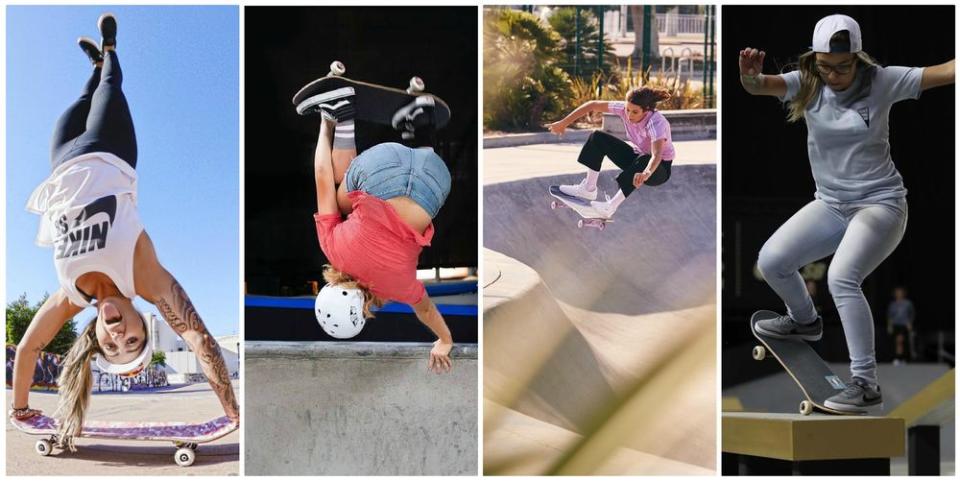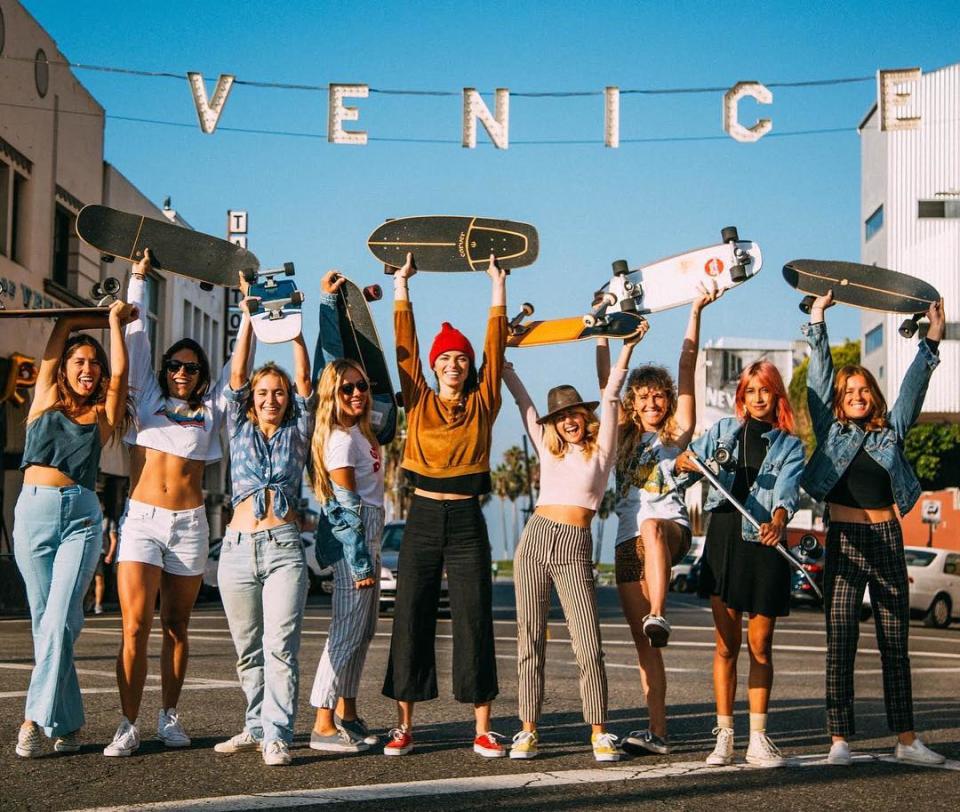Shred like a girl: How women are reinventing skateboard culture
It’s a chilly Tuesday evening in November when I meet the women of GRLSWIRL—pronounced “girl swirl”—at the iconic Venice Beach skate park in Los Angeles. I’m with four of the group’s nine founding members: Lucy Osinski, Monroe Alvarez, Lindsey Klucik, and Kelsey Harkin; Harkin is pregnant so she’s not skating tonight, but she’s here to support the group anyway.
Formed about a year ago, GRLSWIRL is a community of female-identifying skaters of all levels who get together every two weeks in Venice to cruise and help each other grow.
“As a female, skating with other females is super empowering,” Harkin said. “We all teach other and learn from each other, and we all try to grow together. If one person’s doing better than another person, it’s not a competition. We’re like, you deserve that. You’ve been working so hard, you go girl.”
Tonight, there are about two dozen skaters here, from 5-year-old Penny to Natalie from London who got on a board for the first time at age 32. About two-thirds of the group are joining GRLSWIRL’s group skate for the first time, and almost all found GRLSWIRL through social media. One woman, Mary, moved to Los Angeles from North Carolina about four months ago and was thrilled to find the group. “I used to follow my brother to the skate park when I was in elementary school,” she said, “and I’ve just never known any girls who love to skate. So I was very stoked when I found your Instagram page.”
I know all of this because GRLSWIRL starts every skate with a group stretch and get-to-know-you circle; every skater shares her name, where she’s from, and how long she’s been skating. For some, tonight is their first time on a board—one woman reported that she’d been skating for “about an hour and a half”—while others were inspired to start skating again after learning about this group. That’s the thing about GRLSWIRL—it makes you want to skate. It even made me want to skate, a person who cruised around on a board at age 9 because my 14-year-old brother made it look cool, but gave up when he started going to skate parks that seemed to have an implied “no girls allowed” rule. GRLSWIRL is welcoming, and it’s that spirit of inclusion and #womensupportingwomen that defines a new generation of female skaters who are changing the culture, one Instagram post and YouTube video at a time.

GRLSWIRL isn’t the only group of its kind. In the past few years, all-female skate crews have been popping up all over the country and getting a ton of attention: there’s the Santa Cruz Lady Lurkers in Northern California; Brujas in the Bronx; Las ChicAZ in Phoenix; and The Skate Kitchen in New York. Groups like these have always existed in the sport, but now women’s skate crews are in the spotlight and highly visible.
The Skate Kitchen, for example, was the subject of a 2018 film by Crystal Moselle. The filmmaker met two of the girls on the subway in 2017 and recruited them to be in a Miu Miu video she was shooting at the time. Soon after, she decided to tell a somewhat fictionalized version of the crew’s story in Skate Kitchen, spending hours and hours with the skaters and their community.
Moselle explained to HelloGiggles that the diverse, all-female crew has done a lot to bring women into the male-dominated sport. “In the past there were tons of skateboarders that were women, but [skate culture] was more focused on pro skateboarding and not about bringing women in,” she said. “What’s interesting now is it’s a very inclusive thing. The Skate Kitchen, they’re all about bringing women into the mix. Like, ‘We see a girl at the park, we’re not going to be a bitch to her, we’re actually going to bring her over to us and give her support.’”
A post shared by TheSkateKitchen (@theskatekitchen) on Oct 4, 2017 at 9:18am PDT
Things are changing at the professional level, too. At the 2020 Winter Olympic Games in Tokyo, women will compete alongside men in the first ever Olympics skateboarding events. Women’s inclusion wasn’t always a given at the Games: Women’s events were added to the Olympics for the first time in 1900, four years after the first modern Olympic Games were held, but plenty of events remained male-only for decades, including ski jumping, which has been an Olympic sport since the first Winter Games in 1924 but only introduced women’s events in 2014. (In 1991, the International Olympic Committee declared that all new sports seeking to join the Games must include women’s events.)
And this past summer, the Dew Tour, one of skateboarding’s big annual competitions, hosted women’s events for the first time in its nearly 15-year history. According to Adam Cozens, the event’s vice president and general manager, it took a while to add women’s events because officials wanted to guarantee an equal prize purse for female skaters.
“Unless the stage is 100% equal, unless the prize purse is 100% equal, it was a non-starter,” he said. “We’ve had a pretty sizable prize purse—six figures for men and for women—so ensuring that everything was equal was really the first part.” He added that since the addition of women’s events, new brands have shown interest in sponsoring the event (the Dew Tour, like other major skate competitions, is funded in large part by sponsors).
Outside of competitions, female skaters are getting more opportunities to work with brands, too, a major source of income for top-level skateboarders. Mimi Knoop, an accomplished pro skater who founded the Women’s Skateboarding Alliance (WSA) and sits on the board of USA Skateboarding, the sport’s national federation, said that while women still aren’t equally represented in magazines, skate videos, and sponsorships, they’re more visible than ever before. “The legacy brands in our industry are now implementing female skaters into their branding, promotions, and marketing,” she said. “Brands are realizing women’s skating is now popular, and that, well, there’s a market now where before it was super niche.”
That’s certainly true of Nora Vasconcellos, a world champion skater and the first woman to ride for Adidas. She joined the Adidas team in late 2017, just a few months after Welcome skateboards released her pro model board (she’d been riding for Welcome for four years at that point). She told HG that getting her pro board was one of the best moments of her career to date.
“It meant so much because of the team I ride for and because Welcome is like family to me. [Getting your pro board] is one of the most pivotal parts in any professional skater’s career—it was just so cool,” she said. “And then we went to Disneyland for a whole day—that was like the cherry on top.”
That pro board helped her land her contract with Adidas, and her signature Adidas shoe was released last summer, a pastel purple low-top canvas sneaker covered in Vasconcellos’s original artwork.
“I think because I had a lot of really good connections and was already beginning to create a brand for myself and a look, I think that helped [get me the Adidas contract],” she said. “I was my own person, and I didn’t fit the mold of anybody they’d seen in the past.”
A post shared by Nora Vasconcellos (@noravexplora) on Jul 9, 2018 at 8:02am PDT
Women like Vasconcellos are fast becoming icons of the sport. Beneath a video announcing her partnership with Adidas, fellow skater Dale Decker commented, “Nora is such a great ambassador for skateboarding…This [YouTube video] made me feel the same way I felt when I decided all I wanted to do for the rest of my life was skateboard. Thanks Nora.” And Cozens noted that the rising popularity of women’s skateboarding is encouraging more young girls to come out to competitions to see their idols shred.
“Seeing young families and kids and girls in the stands watching women like Letícia [Bufoni] or Pamela [Rosa] or Nora [Vasconcellos] or Jordyn [Barratt] skate—I think it’s pretty cool and pretty empowering,” he said. “When you think of skateboarding today and you think of the heroes, 25 years ago your heroes were Tony Hawk or Danny Way or whatever—obviously male skaters. But when you look at today, I think some of the biggest heroes in the sport are now women.”

Back in the day, riding into a skate park was intimidating for most girls because there was no one there who looked like them. As a pre-teen, Vasconcellos’s dad would drive her 45 minutes to a skate park near where she lived in Pembroke, Massachusetts; she was the lone female rider most of the time, even though the park was reserved for girls and women on Tuesdays.
“There was one other girl that was probably the same age as me, but there weren’t really many to meet, so I just became friends with some of the guys,” she recalled. “It was kind of nice [to skate alone] because it was an escape from school and from team sports and from all the other things…[but] I think I would have been very happy to have many friends to skate with. It was just where I was from and the time.”
Knoop said that while she hasn’t experienced sexism in the sport, per se, growing up in the ‘90s, she definitely felt uncomfortable at the skate park. “Years ago, it was more of an intimidating feeling to go and stand out and be the only person at the skate park that was a girl. You just felt eyes on you,” she said.
That discomfort is part of the reason GRWLSWIRL first formed. The women I spoke to explained that, because skateboarding has long been male-dominated, as a woman on a board you’re either dealing with catcalls (especially on the Venice Boardwalk), feeling out of place or watched at the skate park, or stuck learning how to skate from a dude.
“[That’s] why I think we all came together in the first place. I was searching for people, and I think they were searching for people, specifically women, to skate with to feel a) less vulnerable but b) more empowered,” Osinski said. “Not just being the cutesy girl who’s hanging out. It’s like no, we’re on a board, we can charge and do all these things just as much as you can, and we can do it at our own speed and have fun together and giggle and laugh and dance and be stupid, and not feel bad about it, not feel intimidated.”
In the past, female skaters have sometimes been relegated to a “groupie” role. In a 2016 interview with NYLON, Chanelle Rezko, one of the all-female founders of Get Born skate magazine, explained that she and her co-creators started their mag because male-dominated outlets weren’t representing women in a real or respectful way. “Women who tried to get involved in skateboarding were, and still are, often sexualized and viewed as groupies,” she said. “We had way too much genuine love for the culture to buy into that stereotype, which is why we decided to work to change it and to create a voice for ourselves.”
All the hard work women have been doing to change the culture is paying off. In Venice, guys are starting to take notes from the GRLSWIRL girls.
“One of the guys that’s always at the skate park said to me, ‘The camaraderie that you guys have together, and [how] you guys come and you hang out and you’ve developed this amazing community that skateboarding used to be, I want to show the guys at the skate park what you guys are doing and try to mimic what you guys are doing,’” said Harkin.
Moselle experienced something similar at a screening of Skate Kitchen in London. “This guy raised his hand—and he’s this young skater dude, like 19 maybe, really cool kid—and he’s like, ‘I’ve never seen a movie that made me want to be a woman.’” After a screening in Russia, too, a young girl approached Moselle near tears. “She was practically crying and saying that this was so important to her because she hadn’t ever seen something she could identify with, that the things she’s feeling and going through are happening to other women and it just touched her so much. That was a super fulfilling moment.”
And these women aren’t slowing down. In addition to regular group skates, the GRLSWIRL founders now host regular skate workshops for young girls in L.A., especially in lower-income communities where the sport isn’t as accessible, hoping to pay forward the sense of community and empowerment they’ve developed together.
A sunny day in Venice // ???? @artmosphere______ @ganna_bogdan
A post shared by GRLSWIRL (@grlswirl) on Feb 20, 2019 at 2:22pm PST
It’s taken a lot to progress the sport to this point. Female skateboard pioneers like Elissa Steamer, the first woman to go pro, and Knoop worked for years with all-male teams, seeing few of their peers get recognition or sponsorship. But our culture more broadly has changed—we have more women in office than ever before, women directors are crushing it on the big and small screens, and women’s stories of abuse are finally getting the attention they deserve. All of that has bled over into the world of skateboarding, and there are a few factors in particular that have helped change the look and feel of the sport.
For one thing, skateboarding is a lot more mainstream now than it was in the ‘90s. “It was an outsider sport. Even the boys that did it, it wasn’t encouraged—it was more like outsider, rebel-type kids that did that,” Knoop said.
Now, though, those rebel kids are parents—and they’re encouraging their own kids to get on boards. Said Knoop, “The stigma around skateboarding has changed for everyone, and I think that in itself has made it okay for little girls to start skating.” That mainstream acceptance has also meant that skate parks have popped up all over the country, making skateboarding more accessible to kids outside of big cities; it’s made it safer, too, since young skaters can cruise the parks instead of riding around in the streets.
But social media has undoubtedly provided the biggest boost of all to female skaters, especially Instagram and YouTube. A decade ago, before those platforms were what they are now, a girl skating alone in her town would have almost no way of knowing there were other girls like her skating around the country. The women I spoke to said being a girl skater was often an isolating experience, so finally seeing other girls killing it in Instagram clips or YouTube videos was a game-changer.
“When you’re in a small town before social media, you’re just like, ‘Why am I the only one on this board? I feel stupid,’” said Osinski, who grew up in Cornwall, N.Y. “I never got on a skateboard—all my guy friends did, all the hot guys did. I always thought they were really cool. But now, because of the internet, it’s like ‘Oh wait, there’s other people doing that too, I can be a part of it also.’”
Cozens, the VP of Dew Tour, explained that 20 or 25 years ago it was Transworld Skateboarding, Thrasher magazine, and skate videos that defined what skateboarding looked like (i.e. mostly male), so user-generated content has done a lot to disrupt that narrative and broaden the overall picture of the sport.
On top of that, Knoop said that social media has also helped raise the level at which all athletes are skating. “The ability level now is absolutely crazy, and it’s because of Instagram clips,” she said. “Even a lot on the men’s side, you’ll see—they call them Average Joes. Some kid in Middle America will post this crazy clip of this crazy trick, then other kids see it and it moves the needle.”
@ninamoninamoninamo ???????????????? flip kick
A post shared by TheSkateKitchen (@theskatekitchen) on Sep 12, 2017 at 6:59pm PDT
Of course, it’s not a perfect picture for female skaters just yet. There’s still a boys’ club vibe in many skate parks, which makes it hard for a solo female rider to feel comfortable cruising around and practicing tricks. And women at the professional level aren’t earning as much as their male counterparts.
“There is definitely a gender pay gap in skateboarding,” said Knoop. “The top women simply get paid less than the top men. A lot goes into this, including target marketing, customer base/audience, etc.—it’s a business at the end of the day. Skateboarding was largely marketed solely to young boys/men all of these years. Now the women’s market has emerged and it will only go up from here, in my opinion. For all we know, women could be paid more than the guys in the future!”
Still, there’s never been a better time to be a woman on a skateboard. “Skateboarding has become a vehicle for these women to gather and share something they love to do together,” said Knoop. “The internet and social media have given them a stage to share with others as well.”
And things are only improving. Said Vasconcellos, “Seeing women do cool shit and being accepted not only by other girls or younger girls but little boys and men who look up to these women and find them to be their idols, I think that’s a pretty cool thing.”


